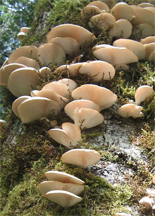Our farm is heavily wooded: cedars, maples, and alder. The cedars are lovely. The maples majestic, plus they offer wonderful nectar for the bees. Alders provide the bees with pollen in February and March. But alders snap, leaving tall broken snags behind. These become home to burrowing insects, foraging areas for woodpeckers, hives for feral bees, and massive oyster mushroom “logs” in the spring.
Oyster mushrooms are one of our delicious native fungi which grow on dead alder. The probably grow on other trees as well, but they love our alders. When the weather is right (lots of rain followed by cool sunny days) a moss-covered snag can suddenly be coated in delicate, yummy mushrooms.
The challenge at times is how to get up the brittle alder to harvest this bounty. On some trees I just shrug and figure time will provide the answer. The mushroom spoors will spread over the alder. Meanwhile, the mushroom mycelium will spread though the snag and, one day, produce “fruits”, oyster mushrooms, that I can reach.
This is the year for one tree that has teased me over the last 5 years. The mushrooms are at my height and are providing a delicious addition to breakfasts and dinners.
The bees? Oh they’re fine. Splits are being made, some with swarm cells, some with nucs. I’ll talk of those later. But now, the oyster mushrooms call.



